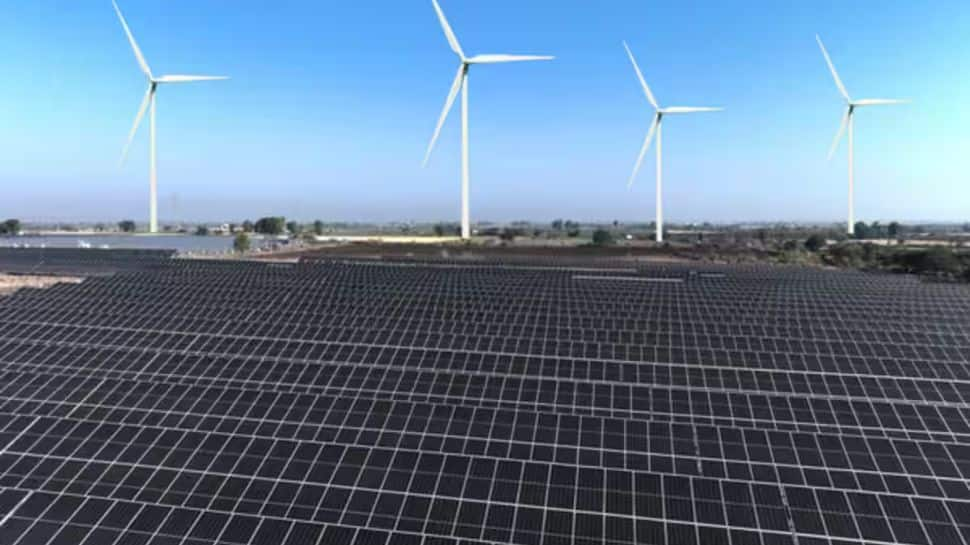New Delhi: China is solidifying its position as the global leader in renewable energy development, with 180 GW of utility-scale solar and 159 GW of wind power currently under construction. This combined total of 339 GW is nearly twice the capacity of the rest of the world combined, according to new data from Global Energy Monitor (GEM).
The 339 GW under construction represents one-third of all proposed wind and solar capacity in China, dwarfing the global construction rate of just 7%, as reported in GEM’s latest Global Solar Power Tracker and Global Wind Power Tracker updates. This stark contrast underscores China’s active commitment to expanding its renewable energy projects.
China is making significant strides in renewable energy, with plans to build 339 gigawatts (GW) of utility-scale wind and solar projects, according to a report by the U.S.-based think tank Global Energy Monitor (GEM). This capacity accounts for 64% of the global total, showcasing China’s leadership in this sector.
In comparison, the United States ranks second with a project pipeline of 40 GW, which is more than eight times smaller than China’s. This highlights China’s strategic focus on transitioning to cleaner energy sources.
China Dominates Global Utility-Scale Solar and Wind Construction
China is home to almost two-thirds of the world’s utility-scale solar and wind power capacity currently under construction. In the past year, China added nearly double the amount of utility-scale solar and wind power capacity compared to any previous year.
By the first quarter of 2024, China’s total utility-scale solar and wind capacity reached 758 GW, with the China Electricity Council reporting a total capacity, including distributed solar, of 1,120 GW. Wind and solar now account for 37% of the country’s total power capacity, an 8% increase from 2022, and are widely expected to surpass coal capacity, which currently stands at 39%, by the end of 2024.
Explosive Growth in Solar and Wind Capacity
cSolar capacity first surpassed wind in 2022, and the gap has since widened significantly, driven by the rapid expansion of distributed solar. Nearly half of the distributed solar added in 2023 was installed on residential rooftops, largely due to China’s “whole county solar” model. Distributed solar now accounts for 41% of China’s total solar capacity, with a higher growth rate than centralized solar since 2021, thanks to lower investment costs, easy installation, and strong policy support.
Newly installed wind capacity also doubled over the past year. After a brief slowdown in 2022 following the end of central government feed-in tariff subsidies, wind installations rebounded in 2023. GEM’s Global Wind Power Tracker documented a 51 GW increase in wind capacity since 2023 — a growth that exceeds the total operating capacity of any country except the United States.
Future Projections and Provincial Leaders
The combined capacity at pre-construction and announced stages for utility-scale solar power reaches 387 GW, and 336 GW for wind. This includes the second and third waves of “mega wind & solar bases” with a combined capacity of approximately 503 GW, expected to come online between 2025 and 2030. Most of the 97 GW in the first wave, announced in 2021, began operating in 2023 as scheduled, pointing to a promising future for subsequent waves.
On the provincial level, GEM’s data reveals that northwest and north provinces continue to dominate large-scale solar and wind installations, while distributed solar is rapidly transforming the landscape in central and southern provinces. Henan, Jiangsu, and Zhejiang have risen to the top five for solar capacity compared to the beginning of 2023.
The top six provinces for wind installation — Inner Mongolia, Xinjiang, Hebei, Shanxi, Shandong, and Gansu — account for 43% of the national total. Offshore wind is also advancing rapidly, with Jiangsu leading the country and Fujian witnessing the operation of the world’s largest single wind turbines at the Pingtan offshore wind farm. The growth in offshore wind capacity in Guangdong, Zhejiang, Fujian, and Hainan is expected to shift provincial rankings in the coming years.
Challenges and Future Outlook
Looking ahead, China could reach 1,200 GW of installed wind and solar capacity by the end of 2024, six years ahead of the pledge made by President Xi Jinping and one year earlier than GEM’s forecast from the previous year. Despite not signing the tripling renewables commitment at COP28, China supported the pledge in the Sunnylands Statement with the U.S. government to triple renewable energy capacity globally by 2030 from 2020 levels. If China continues to add 200 GW annually as planned for 2024, tripling renewable capacity by the end of 2030 is well within reach.
However, challenges remain. China’s coal-centered grid must absorb the unprecedented surge in renewable energy and deliver it to demand regions. Despite fast growth in power storage capacity, the grid still heavily relies on coal power to mitigate the intermittency of renewables. Additionally, the transmission of electricity, largely deployed in north and northwest regions, relies on Ultra High Voltage (UHV) transmission lines, which are currently insufficient for the continued surge in renewable power.
In 2023, China saw unprecedented growth in wind and solar capacity, ensuring its continued leadership in renewable energy installation. However, the country must address these challenges to turn the massive renewables buildup into power generation, replace fossil fuels, and peak its carbon emissions as early as possible.

